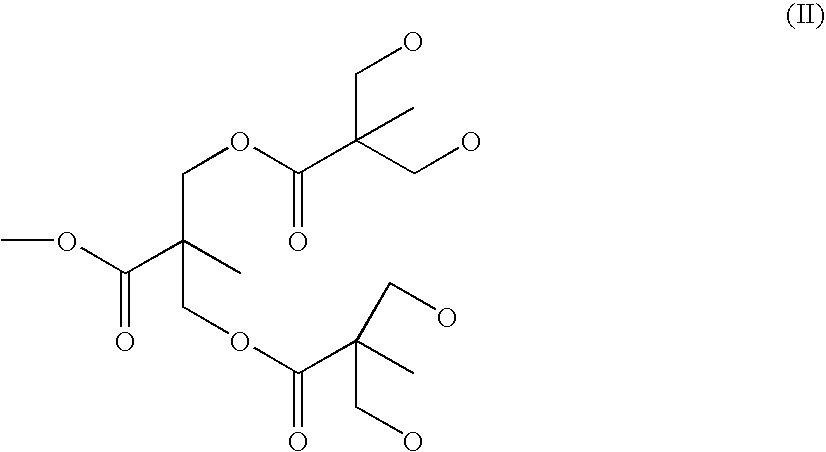Dendritic compound and use thereof
a technology of dendritic compound and compound, applied in the field of dendritic compound, can solve the problems of large loss, difficult to massively accumulate imaging agent on a certain position, and great disadvantage for clinical application of prior art non-polymer gd-dtpa imaging agents
- Summary
- Abstract
- Description
- Claims
- Application Information
AI Technical Summary
Benefits of technology
Problems solved by technology
Method used
Image
Examples
example 1
Preparation of dendritic compound P-D1-(DTPA)
a. Preparation of the First Generation Benzylidene Protected Chelate P-D1-(O2Bn)
[0019]PEG diol (MW 4000 Da, 9.2 g, 2.3 mmol, 1 eq) and DMAP (0.1670 g, 0.39 mmol) are mixed in a round-bottom conical vial. The mixture is dissolved in a 25 mL of DCM and then the vial is filled with nitrogen gas. Benzylidene-2,2-bis(oxymethyl)propionic anhydride (4.27 g (10 mmol)) is dissolved in another vial, and then slowly dripped into the reaction vial. After 24 hours of stirring and reacting in room temperature, 10 ml methanol is added and the reaction is kept for another 6 hours for removing the un-reacted Benzylidene-2,2-bis(oxymethyl)propionic anhydride. An excessive amount of ethyl ether (700 mL) is added and the mixture is stirred until white precipitates are released, and the yield rate is about 90%. Among the products, the Dn is D1 with the structure of (I) as follows:
[0020]
[0021]IR (cm-I): 2890, 1738, 1150.
[0022]1H NMR (400 MHz, CDCl3): δ 1.06 (s...
example 2
Preparation of Dendritic Compound P-D2-(ODTPA)
a. Preparation of Chelate P-D2-(O2Bn)
[0029]The principle of preparing the second generation P-D2-(O2Bn) product is approximately the same as that of the first generation. P-D1-(O2Bn) (95.6 g, 0.83 mmol, 1 equiv) and DMAP (0.326 g, 2.6 mmol, 3.2 equiv) is mixed and then dissolved in 25 mL DCM. After Benzylidene-2,2-bis(oxymethyl)propionic anhydride (13.3 mmol, 16 equiv, 5.69 g) is added, the mixture is stirred at room temperature for 24 hours. Un-reacted Benzylidene-2,2-bis(oxymethyl)propionic anhydride is removed with 15 mL Methanol. Then ethyl ether is used to release the white precipitate at a yield rate of 80% after freeze-drying. The product Dn is D2 with the structure (II) as follows:
[0030]
[0031]IR (cm-I): 2885, 1740, 1100.
[0032]1H NMR (400 MHz, CDCl3): δ 1.03 (s, 12), 1.26 (s, 6), 3.63 (bs), 3.78 (t, 4), 4.03 (t, 4), 4.38 (s, 8), 4.56 (d, 8), 5.41 (s, 4), 7.19 (m, 12), 7.38 (m, 8).
b. Preparation of chelate P-D2-OH
[0033]The product ...
example 3
Preparation of Dendritic Compound P-D3-(DTPA)
a. Preparation of chelate P-D3-(O2Bn)
[0039]The preparation process of the third generation P-D3-(O2Bn) is similar to that of the first and second generations. The product from step b. in example 2 (2.88 g, 0.40 mmol, 1 equiv), Benzylidene-2,2-bis(oxymethyl)propionic anhydride (5.48 g, 12.8 mmol, 32 equiv), and DMAP (0.3151 g, 2.57 mmol, 6.4 equiv) are dissolved in 35 mL DCM at room temperature and reacted for 24 hours. The extracting procedure in step a. of example 2 is repeated, and the final product yield rate is about 89%. The Dn product is D3 with the structure of (III) as follows.
[0040]
[0041]1H NMR (400 MHz, CDCl3): δ 0.89 (s, 24), 1.16 (s, 6), 1.17 (s, 12), 3.57 (t, 6), 3.67 (bs), 3.77 (t, 3), 4.15 (q, 6), 4.28 (t, 3), 4.33 (m, 16), 4.55 (d, 16), 5.37 (s, 8), 7.30 (m, 24), 7.35 (m, 16).
b. Preparation of Chelate P-D2-OH
[0042]The product (4 g) from step a. is dissolved in the mixture of DCM and MeOH (1: 1). Pd / C catalyst (0.4 g) is ad...
PUM
| Property | Measurement | Unit |
|---|---|---|
| yield rate | aaaaa | aaaaa |
| yield rate | aaaaa | aaaaa |
| yield rate | aaaaa | aaaaa |
Abstract
Description
Claims
Application Information
 Login to View More
Login to View More - R&D
- Intellectual Property
- Life Sciences
- Materials
- Tech Scout
- Unparalleled Data Quality
- Higher Quality Content
- 60% Fewer Hallucinations
Browse by: Latest US Patents, China's latest patents, Technical Efficacy Thesaurus, Application Domain, Technology Topic, Popular Technical Reports.
© 2025 PatSnap. All rights reserved.Legal|Privacy policy|Modern Slavery Act Transparency Statement|Sitemap|About US| Contact US: help@patsnap.com



